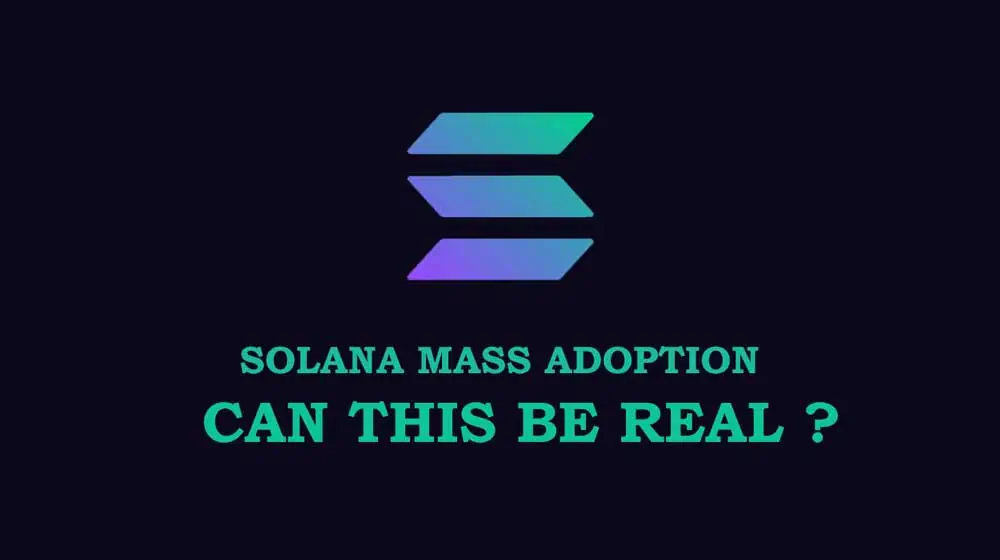Solana Mass Adoption News : Blockchain adoption is on the rise—and this revolutionary decentralized digital technology is evolving at a rapid pace.
Among the newest generations of blockchains, Solana is an innovation that was founded in 2017 with the aim of tackling Ethereum’s operational roadblocks. At its core, Solana exists to hone in on Ethereum’s high running costs (as well as transactional fees), security weaknesses, and sporadic performance speeds.
To date, this new breed of blockchain technology has delivered on its promises to a large extent and as such, it has the potential to scale significantly—but, while that may be the case, adoption has proved slow.
Solana Mass Adoption : the barriers to growth
Despite the fact that Solana has the ability to run at an impressive rate of 50,000 TPS (transactions per second)—thanks to PoH, or Proof of History, verification protocol—adoption has started to plateau.
In recent times, Solana’s primary cryptocurrency, Sol, experienced a market drop of around 42% in January 2022. But, as Solana is in its infancy compared to many other branches of blockchain, this plummet does suggest teething problems rather than existential danger.
Essentially, it is teething problems that appear to present the biggest barrier to Solana’s long term success. Yes, Solana, as well as Sol, are attractive (and potentially prosperous) due to their innate ability to scale seamlessly—but in a rather ironic twist, this budding blockchain player is suffering from growing pains—as coined by co-founder and CEO, Anatoly Yakovenko.
These growing pains are largely due to a drop of transaction times, which is a challenging roadblock considering speed and performance are among Solana’s key USPs. In addition to sluggish transactions and general performance issues, Solana has also seen a series of outages within the past 12 months, crashes that have served to damage the technology’s reputation.
Technical Challenges For Solana Mass Adoption
– Because the transaction costs are so low, it’s possible for bots to post spam transactions to get ahead
– Solana lacks a gas fee market. This means it’s impossible to prioritize the genuine transactions from the spam ones
1. Network Outages
Solana network is not the most stable one out there, outages happen. This kind of network behavior doesn’t earn Solana good press and investors’ experience – nobody like to have their funds frozen at any point and at any time.
2. Higher Centralization
Each blockchain needs to make a design decision – if it wants to be scalable, decentralized or secure – they can pick two. Solana decided on scalability and security. In general crypto space, there is a preference for more decentralized projects.
3. Skepticism slows down adaptation
As mentioned earlier, blockchain and crypto space tend to promote decentralization more than performance. So the ideal project should be decentralized and secure first and later high performance. Solana’s unpopular design decision is preventing the network to grow in peace which would prove the architecture and the performance it could deliver – without a proper scale the stability of the network cannot be achieved and maintained.
The growth potential of solana and Sol
Solana’s path to growth has not been particularly smooth, but the platform’s potential for growth remains.
The timestamped transactional model coupled with its proof of stake consensus offers a treasure trove of opportunity for investors and developers alike.
Another aspect of Solana that is primed for mass adoption and significant growth is the fact that there is no minimum stake requirement to be a node on this particular branch of blockchain.
With the barrier to entry low, Solana and indeed Sol, have the potential to be incredibly attractive options to anyone looking to dip their toes in blockchain waters. Coupled with a framework dedicated to preserving user security, and you have a tonic for sustainable success.
What does the future hold for Solana? Trends and predictions
Growing pains and teething issues aside, the general consensus is that Solana is a branch of the blockchain worth considering as an investment.
The route to mass adoption is moving more slowly than originally expected, but with an excess of $37.9 billion transactions handled to date, the evolution of Solana, and Sol, seems inevitable.
Industry experts predict that Solana will grow at a steady rate over the next three to five years, with a projected value of $2,214.2 by 2027.
Once Solana’s growing pains are ironed out and its scope broadens, the technology will gain the leverage required to take on or potentially surpass blockchain rivals including Ethereum, Cordano, Polka Dot, and Binanance Coin.
Here are some additional key predictions concerning the growth and adoption of Solana:
- Due to its intuitive programmability and its ability to facilitate smart contracts, NFTs, and the development of decentralized finance applications, Solana is likely to become a pivotal part of thousands of new projects in the coming years
- As exchanges, transactions, and exchanges begin to rise across sectors, Solana’s unlocked value will increase, further showcasing its potential to new investors and developers
- To combat the criticism that Solana is a little too centralized, internal developers will increase its number of validators to rival or exceed Ethereum’s current 275,830-plus
- As regulation within the cryptocurrency space becomes more stringent, Solana may experience some slow patches of growth within the next two to five years, but experts predict that it will continue on a positive trajectory
- With industry growth will come new blockchain innovations: competitors (smart contract-based cryptos in particular) that Solana will need to consider to keep a firm foothold in the market in the long run
- Solana is likely to play a significant role in development of the rise of the metaverse. In fact, it could rival the likes of Star Atlas (ATLAS) as a multiplayer-style metaverse currency or token. This development, if realized, will spark exponential growth for Solana
Transactional and performance-based issues have plagued Solana’s success in recent times, but with a wealth of benefits to unlock, the platform’s future looks bright. The threat of new regulation as well as fresh competition always looms in the world of blockchain and cryptocurrency, but once Solana gains momentum, mass adoption is certainly on the cards.
The next 12 months will prove pivotal for Solana and the exact rate of its growth will depend on its ability to tackle any existing technical difficulties.
In summary, will mass adoption become a tangible reality? There are no certainties in the digital realm, but, yes, Solana has every chance of expanding its horizons in the not so distant future.
For more news on the world of blockchain and crypto, read Is The NFT Bubble About To Burst?









